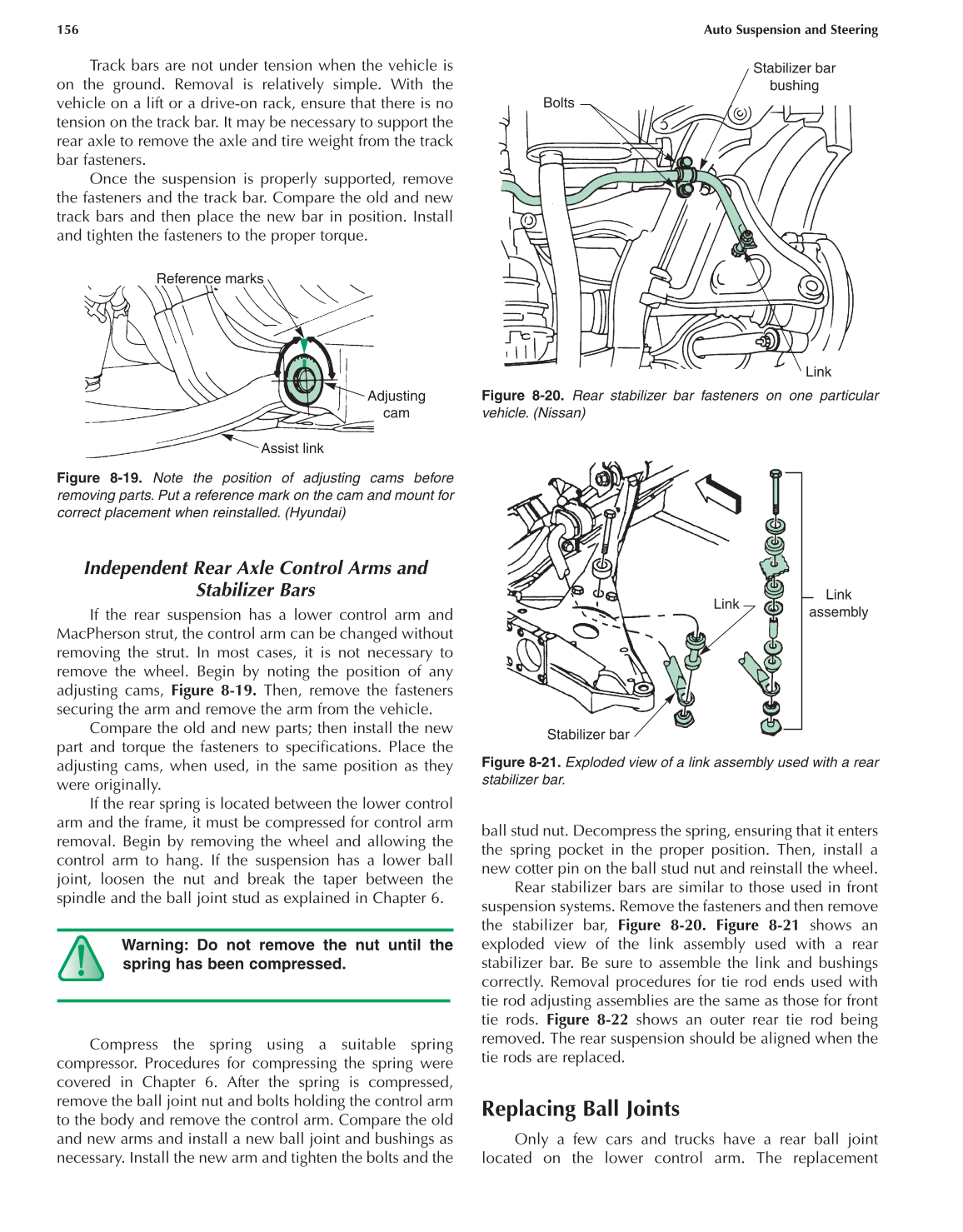156 Auto Suspension and Steering
Track bars are not under tension when the vehicle is
on the ground. Removal is relatively simple. With the
vehicle on a lift or a drive-on rack, ensure that there is no
tension on the track bar. It may be necessary to support the
rear axle to remove the axle and tire weight from the track
bar fasteners.
Once the suspension is properly supported, remove
the fasteners and the track bar. Compare the old and new
track bars and then place the new bar in position. Install
and tighten the fasteners to the proper torque.
ball stud nut. Decompress the spring, ensuring that it enters
the spring pocket in the proper position. Then, install a
new cotter pin on the ball stud nut and reinstall the wheel.
Rear stabilizer bars are similar to those used in front
suspension systems. Remove the fasteners and then remove
the stabilizer bar, Figure 8-20. Figure 8-21 shows an
exploded view of the link assembly used with a rear
stabilizer bar. Be sure to assemble the link and bushings
correctly. Removal procedures for tie rod ends used with
tie rod adjusting assemblies are the same as those for front
tie rods. Figure 8-22 shows an outer rear tie rod being
removed. The rear suspension should be aligned when the
tie rods are replaced.
Replacing Ball Joints
Only a few cars and trucks have a rear ball joint
located on the lower control arm. The replacement
Reference marks
Adjusting
cam
Assist link
Figure 8-19. Note the position of adjusting cams before
removing parts. Put a reference mark on the cam and mount for
correct placement when reinstalled. (Hyundai)
Independent Rear Axle Control Arms and
Stabilizer Bars
If the rear suspension has a lower control arm and
MacPherson strut, the control arm can be changed without
removing the strut. In most cases, it is not necessary to
remove the wheel. Begin by noting the position of any
adjusting cams, Figure 8-19. Then, remove the fasteners
securing the arm and remove the arm from the vehicle.
Compare the old and new parts; then install the new
part and torque the fasteners to specifications. Place the
adjusting cams, when used, in the same position as they
were originally.
If the rear spring is located between the lower control
arm and the frame, it must be compressed for control arm
removal. Begin by removing the wheel and allowing the
control arm to hang. If the suspension has a lower ball
joint, loosen the nut and break the taper between the
spindle and the ball joint stud as explained in Chapter 6.
Warning: Do not remove the nut until the
spring has been compressed.
Compress the spring using a suitable spring
compressor. Procedures for compressing the spring were
covered in Chapter 6. After the spring is compressed,
remove the ball joint nut and bolts holding the control arm
to the body and remove the control arm. Compare the old
and new arms and install a new ball joint and bushings as
necessary. Install the new arm and tighten the bolts and the
Bolts
Stabilizer bar
bushing
Link
Link
assembly
Link
Stabilizer bar
Figure 8-20. Rear stabilizer bar fasteners on one particular
vehicle. (Nissan)
Figure 8-21. Exploded view of a link assembly used with a rear
stabilizer bar.
